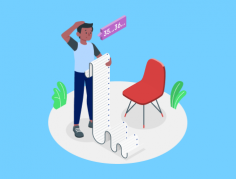- System Features
- FAQ
- Contact Us

What is an Expense Compass?
Documentation of purchases made with self-employed and non-taxpayers or a document issued for the return of a sold good is called an expense compass.
In Which Situations Is the Expense Compass Arranged?
Article 234 of the V.U.K (Tax Procedure Law) adjusts the expense slip and classifies the expense slip with the same status as the invoice. Accordingly, the situations where an expense slip can be issued are as follows;
1. In cases where services or goods are received from tax-exempt tradesmen and non-taxpayers,
2. In the event of the consumer return of a previously sold product,
3. In the case of receiving fixed assets from taxpayers in simple method,
4. When works are taken from those who benefit from the exemption regulated in Article 18 of the Income Tax Law,
5. And finally, when payments are made to those who are self-employed incidentally, the expense slip can be issued.
The scope of the expense compass has been expanded with the periodically published communiqués by the Ministry of Finance, and in this context, it has started to be used in the documentation of the products, goods and services received from the final consumer, as well as the payments such as royalty payments, as well as the commercial activities with tax-exempt tradesmen.
Who Uses Expense Compass?
Those who use an expense slip in Article 234 of the Tax Procedure Law;
“First and second class traders, self-employed and farmers, whose earnings are determined by simple method and who are obliged to keep a book: To tax-exempt tradesmen; The expense slip, which they will arrange for the works they have made or the commodities they buy from them and have them signed by the person who does the work or the seller of the commodity, is the invoice issued by the tax-exempt tradesman. This document is also issued for precious items such as gold and jewelry that first and second class traders buy from people who sell their personal belongings.
The expense note includes the nature of the work, the type and type of the commodity, the amount and price, the work fee and the work wage and the names, surnames (titles in legal persons) and the address and date of the contractor or buyer or seller of the commodity, and is issued in two copies the copy is delivered to the person who does the work or who sells the goods. Expense slips are arranged in series and sequential numbers. " It is shown as.
How is the Expense Compass Arranged?
The regulation made by the Ministry of Finance, which stipulates the form and procedure of the expense slip in the Tax Procedure Law's 225th Communiqué, is as follows;
1. In the expense slips; the nature, type, number, price, amount, total, withholding tax rate and net amount, names and surnames (titles in legal entities), addresses, if any, the tax office and account number, serial and information on the joint sequence number and date of issue will be included.
2. Expense slips will be prepared in at least two copies. Expense slips that are not prepared in at least two copies and whose information are incomplete will be deemed not to have been prepared.
3. The first copy of the expense papers will be given to the person who does the job or the seller, and the second copy will be kept by the organizer.
4. Expense slips will be printed by the taxpayers in contracted printing houses or certified by the notary. The provisions of the "Regulation on Printing and Distribution of Documents Used by Taxpayers Pursuant to the Taxpayer Law" shall be complied with when the expense slip is not printed or used in contracted printing houses.
Expense Compass Withholding Rates
The rate of withholding tax to be collected from the payments made in return for the purchases of goods and services from tax-exempt tradesmen, regulated by Article 94 of the Tax Procedure Law, varies. According to this:
1. Towels, sheets, socks, carpets, rugs, woven products, knitting, lace, all kinds of embroidery and all kinds of tourist goods, mats, baskets, brooms, mops, brushes, artificial flowers and similar commodity prices or paid for the manufacture of this commodity. over service fees, (2%)
2. In scrap goods purchases (2%)
3. For other goods purchases (5%)
4. For other service purchases (excluding the sub-clauses above, the failure to separate the cost of goods and services is also within this scope), (10%)
5. If the person from whom the goods or services are purchased is not a taxpayer and does not benefit from the exemption of tradesmen and sells the goods of real and legal persons to the consumer by going door-to-door on behalf of them, without being bound by the employment contract, a withholding tax (20%) is applied from payments such as commission and premium.






















